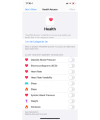Leveraging mHealth Technologies for Public Health
- PMID: 39265164
- PMCID: PMC11427850
- DOI: 10.2196/49719
Leveraging mHealth Technologies for Public Health
Abstract
Traditional public health surveillance efforts are generally based on self-reported data. Although well validated, these methods may nevertheless be subjected to limitations such as biases, delays, and costs or logistical challenges. An alternative is the use of smart technologies (eg, smartphones and smartwatches) to complement self-report indicators. Having embedded sensors that provide zero-effort, passive, and continuous monitoring of health variables, these devices generate data that could be leveraged for cases in which the data are related to the same self-report metric of interest. However, some challenges must be considered when discussing the use of mobile health technologies for public health to ensure digital health equity, privacy, and best practices. This paper provides, through a review of major Canadian surveys and mobile health studies, an overview of research involving mobile data for public health, including a mapping of variables currently collected by public health surveys that could be complemented with self-report, challenges to technology adoption, and considerations on digital health equity, with a specific focus on the Canadian context. Population characteristics from major smart technology brands-Apple, Fitbit, and Samsung-and demographic barriers to the use of technology are provided. We conclude with public health implications and present our view that public health agencies and researchers should leverage mobile health data while being mindful of the current barriers and limitations to device use and access. In this manner, data ecosystems that leverage personal smart devices for public health can be put in place as appropriate, as we move toward a future in which barriers to technology adoption are decreasing.
Keywords: apps; digital public health; mHealth; mobile health; mobile phone; population health; public health; self-report; smart technology; surveillance; surveys; wearables.
©Pedro Elkind Velmovitsky, Merna Kirolos, Paulo Alencar, Scott Leatherdale, Donald Cowan, Plinio Pelegrini Morita. Originally published in JMIR Public Health and Surveillance (https://publichealth.jmir.org), 12.09.2024.
Conflict of interest statement
Conflicts of Interest: None declared.
Similar articles
-
Comparison of Mobile Health Technology Use for Self-Tracking Between Older Adults and the General Adult Population in Canada: Cross-Sectional Survey.JMIR Mhealth Uhealth. 2020 Nov 27;8(11):e24718. doi: 10.2196/24718. JMIR Mhealth Uhealth. 2020. PMID: 33104517 Free PMC article.
-
Evolutionary Trends in the Adoption, Adaptation, and Abandonment of Mobile Health Technologies: Viewpoint Based on 25 Years of Research.J Med Internet Res. 2024 Sep 27;26:e62790. doi: 10.2196/62790. J Med Internet Res. 2024. PMID: 39331463 Free PMC article.
-
Value of Engagement in Digital Health Technology Research: Evidence Across 6 Unique Cohort Studies.J Med Internet Res. 2024 Sep 3;26:e57827. doi: 10.2196/57827. J Med Internet Res. 2024. PMID: 39226552 Free PMC article.
-
Attributes, Methods, and Frameworks Used to Evaluate Wearables and Their Companion mHealth Apps: Scoping Review.JMIR Mhealth Uhealth. 2024 Apr 5;12:e52179. doi: 10.2196/52179. JMIR Mhealth Uhealth. 2024. PMID: 38578671 Free PMC article.
-
Digital Health Apps in the Clinical Care of Inflammatory Bowel Disease: Scoping Review.J Med Internet Res. 2019 Aug 19;21(8):e14630. doi: 10.2196/14630. J Med Internet Res. 2019. PMID: 31429410 Free PMC article.
Cited by
-
Leveraging Administrative Health Databases to Address Health Challenges in Farming Populations: Scoping Review and Bibliometric Analysis (1975-2024).JMIR Public Health Surveill. 2025 Jan 9;11:e62939. doi: 10.2196/62939. JMIR Public Health Surveill. 2025. PMID: 39787587 Free PMC article.
-
The Interactive Care Coordination and Navigation mHealth Intervention for People Experiencing Homelessness: Cost Analysis, Exploratory Financial Cost-Benefit Analysis, and Budget Impact Analysis.JMIR Form Res. 2025 Mar 18;9:e64973. doi: 10.2196/64973. JMIR Form Res. 2025. PMID: 40101159 Free PMC article. Clinical Trial.
References
-
- Soucie JM. Public health surveillance and data collection: general principles and impact on hemophilia care. Hematology. 2012 Apr;17 Suppl 1(0 1):S144–6. doi: 10.1179/102453312X13336169156537. https://europepmc.org/abstract/MED/22507804 - DOI - PMC - PubMed
-
- Section 1: evaluation of the surveillance function at the Public Health Agency of Canada – Introduction. Public Health Agency of Canada. [2018-10-12]. https://www.canada.ca/en/public-health/corporate/mandate/about-agency/of... .
-
- Lee LM. Principles and Practice of Public Health Surveillance. Oxford, UK: Oxford University Press; 2010.
-
- Kjellsson G, Clarke P, Gerdtham UG. Forgetting to remember or remembering to forget: a study of the recall period length in health care survey questions. J Health Econ. 2014 May;35:34–46. doi: 10.1016/j.jhealeco.2014.01.007. https://linkinghub.elsevier.com/retrieve/pii/S0167-6296(14)00008-3 S0167-6296(14)00008-3 - DOI - PubMed
Publication types
MeSH terms
LinkOut - more resources
Full Text Sources
Medical


